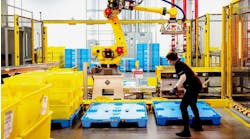The emergence of new-collar jobs with the rise of industrial automation
By Chris Johnson, head of Nokia’s global enterprise business
As digitalization becomes the norm for asset-heavy industries, innovators are working toward a future where people work hand-in-hand with machines. And with one in five workers planning to quit their jobs in 2022, forcing business leaders to rethink working practices to retain talent and prevent brain drain, digitalization and automation can help reduce the staffing shortages these industries are facing.
But how will these new technologies transform work the people who perform it?
Automation and well-being
In the public debate over automation, it is often assumed that automation eliminates jobs. The data doesn’t generally support this. According to Bell Labs Consulting’s The Rise of the New Collar Worker, automation leads to greater productivity, which in turn leads to increased sales, higher wages and shorter hours. The unit price for goods tends to fall, leading to increased consumption. This is why successive industrial revolutions have not led to less jobs and immiseration, as the Luddites once feared, but to increased material well-being, shorter work hours and safer workplaces.
Augmenting workers
We see two trends in automation as part of Industry 4.0. The first is the continuation of robotic automation, replacing predictable and dangerous tasks with increasingly smart, software-driven physical processes that rely on sensors for improved flexibility, mobility and precision. The analytics software driving this enhanced robotic automation will leverage artificial intelligence (AI) and machine learning (ML) to constantly improve precision, speed and quality.
The second trend is worker augmentation. Workers will remotely control equipment, such as vehicles, gantry cranes or shunting engines, and have increasingly sophisticated tools available to perform tasks—think electronic torque wrenches that digitally control for torque, angle and log data. Augmented reality (AR) will use multi-modal terminals, and wearables such as heads-up displays will provide precise task-based knowledge to workers. This will replace in-class training with in-field training and support. Experts and mentors will be able to assist remotely, and workers will have fingertip access to context-based knowledge resources.
The intersection of these two trends means that what were previously considered physical jobs will increasingly have a cognitive component. Job classes involving a higher proportion of unpredictable tasks that require special expertise are more likely to be augmented, while those with a higher proportion of repetitive tasks are likely to be eliminated by automation. The net effect will be overall growth and a shift in the workforce toward “new-collar” jobs.
Agility and resilience
If the 20th century was the age of mass production, mass marketing and mass consumption, the 21st century will reward rapid innovation, speed-to-market and adaptability. Today’s winning industrial enterprises are adopting development and operations processes that look more like the software industry, with capabilities for rapid innovation and continuous development and optimizations.
Meanwhile, external augmentation has already begun to permeate the workforce as robotic automation and remote working become increasingly common. In the long term, external augmentation will accelerate as augmentation technologies grow more sophisticated.
Connectivity
The Industry 4.0 transformation of the workplace—and the worker—is premised on some keystone technologies: IoT, AI/ML and cloud computing. The augmentation of workers will rely, to some extent, on all of these tools, but most heavily on advances in communications such as 5G. Augmented reality, smart tools, smart PPE and multi-modal terminals are largely made possible by improvements in broadband wireless technologies.
This means a shift in the communications infrastructure employed by many industries in the next few years to a more platform-based communications system—think end-to-end private wireless based on LTE, 5G and, in time, 6G. This industrial-grade wireless platform will also be critical for supporting machine-to-machine communications, remote monitoring and management, and autonomous mobility. Supported by this enhanced level of connectivity, the next decade will usher in unprecedented changes in worker augmentation, which will in turn lead to sizable boosts in overall industrial productivity.
The evolution of work
This transformation in the workforce toward hybrid cognitive-physical work will require significant shifts in skills training and education. Workers of the future will expect some aspect of digitalization, so lifelong learning and upskilling will be required to attract those workers and remain competitive. 5G can also be harnessed for AR and VR technologies, which can support both the scope and scale of the training and upgrading that will be needed. Universities, educators, policy makers and technology companies must work together with industry partners to ensure that the workforce is ready to assume these new, more-fulfilling roles.



